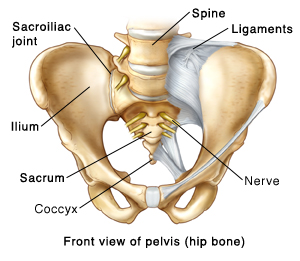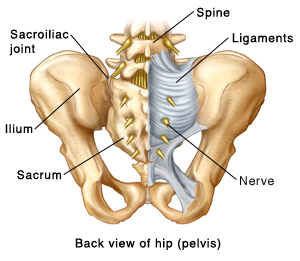Do you have a pain in the area of your buttocks? A real nagging pain that gets worse when you try to put on trousers, stand up, or take walks? Do you feel like your sacrum, the large, triangular bone at the base of your spine is “tweaky” or “off”? These are classic symptoms of sacroiliac joint (SI/SIJ) pain. SI joint exercises and remedial massage can help resolve the SIJ dysfunction.

What Is Sacroiliitis?
Sacroiliac joint pain is frequently misdiagnosed as sciatica, but it is not sciatica at all. While they both can cause discomfort around your buttocks, the pathology behind each is different. SI joint dysfunction often looks like lower back pain, pain radiating into one leg or two, buttock pain on one side (or both), just like sciatica.

What Are the Causes of Sacroiliac Joint Pain?
The sacroiliac joint is where the two halves of the pelvis meet the sacrum. The sacrum and pelvis are connected by strong ligaments. The joint is normally very stable, as it is responsible for transferring weight and forces between the spine & the pelvis. Because it is so important for movements like walking and climbing stairs, having a sacroiliac joint injury can feel debilitating.
What can aggravate the SIJ (not a comprehensive list):
Stability/mobility issue of the sacroiliac joint. Sometimes you’ll notice that the pain is more intense on the side of your sacrum that moves more easily
Overstretched ligaments
An upslip of one pelvic half
Lack of lumbar spine mobility
Asymmetrical movements
Un balanced muscle alignment (see photo below)
Spinal twists where the pelvis is kept stable
Stretching the hips excessively in external rotation- like pigeon pose or number 4 stretch (see photo's below)
In a well-balanced sacroiliac joint, twisting movements, asymmetrical movements, standing for long periods of time, etc., are not problems. Usually a great orthopedic doc or a Physio can help you determine whether you are suffering from SIJ pain or sciatica.

Conventional Approaches to Treating Sacroiliac Joint Pain
Physiotherapy (PT) is one recommendation for treating SI joint pain. Your PT (will focus on bringing balance into the muscles that move the pelvis and spine, so that your SI joint can better stay in its natural alignment. With severe SI joint pain a special SI support belt can be helpful in finding stability until the muscles are more balanced.

Therapy options for SI joint pain include chiropractic care and remedial massage.
A chiropractor can get your SI joint back into place, but getting the muscles around the sacrum in balance is essential for the adjustment to last; physio or movement work will be necessary to sustain the changes.
Some medical practitioners will suggest steroid injections at the SI joint, or fusing the joint via surgery. Again, because determining whether the pain comes from the SI joint is complex, these options are best discussed with your doctor.
Exercises to Relieve SI Joint Pain
With sacroiliac joint issues, they key is to avoid heavy hip stretching. It seems counter-intuitive, but excessive hip and butt region stretching can actually make the joint less stable and cause more discomfort. The key to resolving SIJ issues is to identify the root causes that are pulling your SIJ out of alignment. These can include tight/tense/weak back, hip and thigh muscles. They can also include repetitive movements that we do all day.
Being mindful of how you move, changing some habits that might be causing strain to your pelvis, and learning exercises to stabilise your pelvis are all crucial to ridding yourself of SIJ issues for good.
As always, movement advice does not constitute medical advice. Check with your doctor before you embark on an exercise programme.
It is important to understand that exercises that can help a sciatica issue can often make an SIJ issue worse:


Listing: Standing on one side to strengthen side hips.
Warrior 3/deadlift: Warrior 3/deadlift to strengthen butt muscles
Glute bridges: NOT a yoga bridge, in this exercise, push straight down through the heels to lift pelvis off the floor and slowly lower back down
Stand well: Don’t hike your hips or stand only on one leg. Stand with weight evenly balanced between both feet.
Sit well: Don’t cross your legs or sit back on your sacrum. DO sit on your sitting bones.
Learn a self-adjustment: Lie down on your back with both feet flat on the floor. Pull one knee in toward your chest and hold with your hands. Create a push/pull: pull your knee in with your hands while you resist the pull by pushing with your leg. Hold for 5 seconds and repeat 2 times. Repeat on the other side.
Pigeon pose Don’t do pigeon pose (this is excessive stretching of the hip & butt and could aggravate your SIJ). (Shown above.)
Don’t do butterfly stretch Don’t do butterfly stretch (aka cobbler’s pose—sitting with soles of feet together and knees wide)
Don’t do #4 stretch Don’t do #4 stretch (piriformis stretch with ankle across opposite (shown above).





